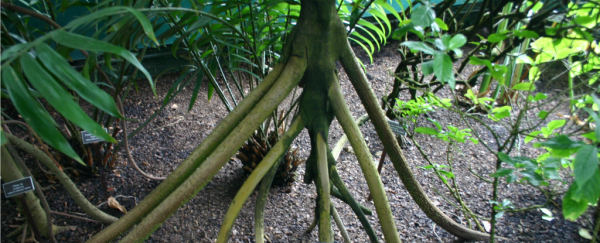They might lack the ability to launch a war against the forces of Isengard, or converge for a meeting about what to do about some pesky hobbits, but a species of tree in a remote section of Ecuador can, reportedly, walk.
You heard that right, there's a very real species of palm tree, Socratea exorrhiza, that can grow new roots to 'sidestep' its way to better soil. And not just a little sidestep, either. These mobile trees can travel about 20 metres a year, according to Karl Gruber from the BBC. Or, that's how the legend goes, but is it true?
It seems like a pretty simple question to answer, but it's so much more complicated than you might expect. Some reports, like Gruber's, claim that the famed trees 'walk' by sprouting new roots, which allows them to sort of sidestep their way very slowly through the forest.
But according to a 2005 paper by biologist Gerardo Avalos, the trees, which do produce new roots on occasion, stay firmly planted in one space. Just because they sprout new roots, doesn't mean they use them to move around.
"My paper proves that the belief of the walking palm is just a myth," Avalos told Live Science's Benjamin Radford. "Thinking that a palm tree could actually track canopy light changes by moving slowly over the forest floor … is a myth that tourist guides find amusing to tell visitors to the rainforest."
So why all the confusion? It all seems to stem (sorry) from the tree's unique root system.
Unlike other trees that have roots fully hidden underground, the walking palm trees have a higher root system that starts near the bottom of their trunks. This leaves the trees looking more like an upright broom than an actual tree. Over time, as soil erodes, some of these roots die off, and new roots form.
So the question is: do these new roots eventually shift the tree's location? All signs sadly point to no.
The walking palm, as cool as it sounds, is probably something cooked up by tour guides to add a bit of spice to their lecturing - a conclusion that is furthered by the fact that, if you do a quick search, there aren't any time-lapse videos of one of these trees 'walking', but a tonne of videos of people saying they do.
While it's disappointing for those of us who really want to believe in the idea that a tree can have some form of mobility other than growing towards the light, there are plenty of plants that do, in fact, move. Take the flytrap, that eats small insects by chomping down on them, or Mimosa pubica - also known as the 'sensitive plant' - that recoils at a touch.
So until someone can either document the walking trees on the move or publish a paper describing them, we have to follow the evidence that says they stay put.
